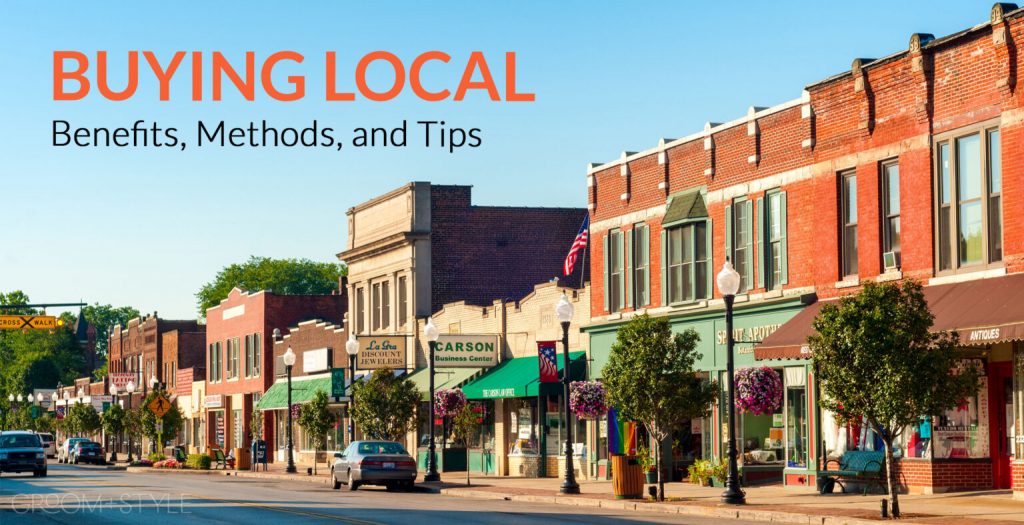This piece was written by Rebecca Moses and originally published in Groom + Style on May 14, 2020.
There’s no doubt that our purchasing decisions are the backbone of the local economy, and whether we buy local or shop at a larger chain often helps determine whether smaller businesses survive and then thrive. Currently, as larger businesses threaten to erode small business communities and many small and local businesses are pinching pennies to survive the COVID-19 pandemic, the practice of buying local is more important than ever.
The threat of the COVID-19 Pandemic restricts the way we live our lives, our budgets, and what we can or can’t purchase. It’s very tempting to give in to any conveniences that present themselves, such as purchasing our goods, foods, and necessities from the easiest, largest sellers. However, constantly taking this option can be potentially devastating to our local communities, as small and local businesses struggle to survive with reduced sales and no foot traffic. As a result, our towns and communities can suffer in the long term for it.
Local businesses, including restaurants, farms, distilleries, wineries, breweries, bakeries, retailers, and trade services, still need your business at this time. Most of them are trying their best to reach you and make their services available to you throughout the pandemic, using shipping and delivery services, curbside pickups, and other flexible innovations.
Here is a guide to get you to start thinking about how your buying habits can help to support your local economy.
What Do We Mean by Local?
When we talk about local shopping, it’s important to distinguish between shopping locally and making your purchases from local businesses. If you’re shopping locally, then you may be going to local branches of a wider chain, as opposed to purchasing online.
However, shopping local normally indicates the decision to primarily patronize businesses that are locally owned and operated.
In this case, you’re making your choice to buy from locally-owned businesses, as opposed to larger retailers or food chains. While both of these in-person options help to support local jobs, buying from local businesses does more for your local economy than buying from larger chains, boosting it while also building relationships.

Local vs Chain
Chain stores are often owned by larger corporations and operated through an external headquarters. This headquarters commands most of the higher-paying jobs while the local branch employs relatively few individuals to operate the store itself. Many individuals resort to chain stores and restaurants due to their familiarity, low prices, and convenience. This reliance on the convenience of larger companies has become a problem as consumers start to feel the pushback of instability from the pandemic.
The current supply situation has caused shock among consumers as they enter stores to find empty shelves. The availability of certain necessities varies from region to region. Nonetheless, shelves carrying meat, produce, and cleaning supplies may remain empty for days. This is likely the result of purchasing at a higher rate than normal, as opposed to a complete lack of supply throughout the chain. Many areas are actively working to adjust their supply chains to the new demands.
Local farmers and many local markets, however, still have a strong supply of produce and animal products. They plan this supply to sell during farmers’ markets, and in the absence of these markets, they have fresh foods ready for purchase.
Key Differences Between Chain and Local Retailers
When it comes to developing a strong local economy, chain stores are not as beneficial as independent and local businesses.
About 45 percent of every dollar of revenue spent at a locally owned business stays in the local community. Additionally, about 9 percent benefits the economy elsewhere in the state. On the other hand, only 14 percent of the revenue spent in a chain store will remain in the local community, and this tends to mostly be the payroll of the employees who work at that chain. The remainder is absorbed by external suppliers or the parent corporation.
While chain stores try to excite a neighborhood with the promise of job creation, they often displace almost the same number of jobs that they would create. At the same time, since the management of these chains is most often removed from the local branch, chain stores offer very limited upward mobility for the vast majority of employees. Instead, they export profits to a corporate headquarters, where they also employ the majority of their services, such as accountants, designers, marketers, central customer service, and others.
Additionally, chain stores normally cost more taxpayer dollars to support than is redistributed to the community through wages. For the most part, these chain retailers do not significantly increase retail sales in a way that strengthens the local economy with increased local tax revenue. Instead, they tend to shift a percentage of sales away from local businesses.
To maintain consistency, each store in a chain tends to be cloned in design, and they generally purchase very few local goods and services. Different chain stores will all have the same or similar products, geared toward what sells nationally, as opposed to local interests. When shopping locally, on the other hand, many of your options will be locally created or produced. This means you can find unique, regionally sourced, and customizable goods.
Continue reading at Groom + Style to learn more about what you can buy local and potential drawbacks and benefits!
 Food
Food Farmers
Farmers Sustainable Living
Sustainable Living Living Planet
Living Planet News
News